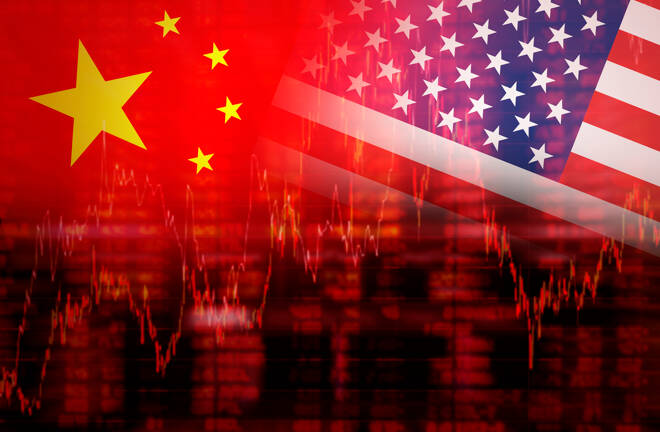Advertisement
Advertisement
US-China Trade Deal Hopes Rise as Beijing Unleashes Stimulus Measures
By:
Key Points:
- US-China trade talks set for May 9–12, with both sides posturing amid fragile economic and political tensions.
- Diverging policies—PBoC eases while Fed holds rates—heighten market uncertainty ahead of key trade talks.
- China’s equity markets outperform year-to-date, boosting investor sentiment ahead of talks.
Can China and the US Reach a Trade Agreement?
Investor focus has returned to the US-China trade war, with a trade agreement seen as crucial for both economies. However, recent rhetoric from both sides suggests negotiations may be lengthy and potentially heated.
Neither Beijing nor Washington appears willing to concede to initiating the talks, highlighting their desire to project strength going into trade talks.
The Kobeissi Letter reported:
“President Trump says China should ‘reassess’ who asked for a trade policy meeting. It appears Trump is signaling that China came to the table first, while China is saying the opposite.’
This week, Beijing confirmed its willingness to engage in talks after evaluating the potential economic benefits of a trade agreement. The Ministry of Commerce reportedly stated:
“China has carefully evaluated the information provided by the United States. After fully considering global expectations, China’s interests, and the appeals of the U.S. industry and consumers, China has decided to agree to engage with the United States.”
With China’s Vice Premier He Lifeng and US Treasury Secretary Scott Bessent expected to meet in Switzerland, trade talks could begin on Friday, May 9, and conclude on Monday, May 12.
Global markets may face heightened volatility as failed talks could revive recession fears and lift demand for safe-haven assets, including gold and the Japanese Yen.
Economic Policy Divergence
As global markets brace for the upcoming talks, the People’s Bank of China (PBoC) took steps to bolster China’s economy on Wednesday, May 7, cutting interest rates and lowering the Reserve Requirement Ratio (RRR).
East Asia Econ remarked:
“China – the PBC won’t have finished yet. The exact timing of monetary easing can vary, but today’s interest rate and RRR cuts are not a surprise. Today’s moves are consistent with the PBC’s usual reaction function, and with inflation so weak, further loosening should be expected.”
The rate cuts followed softer-than-expected April PMI data, reflecting the early effects of the trade war on China’s economy. Brian Tycangco, editor at Stansberry Research, commented:
“Beijing just did what we were all hoping and anticipating for… MORE STIMULUS via lower rates and RRR cuts to unleash a tidal wave of liquidity just as the economy starts to feel the impact of Trump’s trade war. To have the release of stimulus coinciding with potential trade talks between the US and China next week is something to be optimistic about. Deal or no deal, Beijing has made steps to shore up its domestic economy.”
In contrast, the Fed held interest rates steady at 4.5% on May 7. Chair Powell signaled a ‘wait-and-see’ policy stance amid increasing stagflation risks. President Trump may view the Fed’s inaction unfavorably, particularly in the context of trade negotiations.
Peter Schiff, Chief Economist and Global Strategist at Europac, commented:
“Reading between the lines here’s what Powell said. We’re in a lot of trouble. The economy is weak and getting weaker, but the Fed can’t cut rates as inflation is getting stronger. In fact, we should be hiking rates, but we can’t do that either without creating a financial crisis.”
Stimulus and Trade Optimism Lifts Markets
Hong Kong and mainland China equities gained ground on Thursday, May 8, buoyed by Beijing’s stimulus and optimism surrounding the trade talks. The Hang Seng Index rose 0.72% after gaining 0.13% the previous session. The CSI 300 and the Shanghai Composite Index climbed 0.61% and 0.80% in morning trading after Wednesday’s gains of 1.01% and 1.13%.
Despite this week’s gains, the CSI 300 and Shanghai Composite Index remain down 2.62% and 0.27% year-to-date. In contrast, the Nasdaq Composite rose 0.27% on May 7, but is down 8.14% for the year, giving Mainland China’s markets an edge ahead of trade talks.
Outlook
The outcome of US-China trade talks will be crucial for regional markets. Easing tensions and progress toward a trade agreement could boost demand, while stalled talks may trigger a flight-to-safety. Beijing could introduce additional stimulus to counteract the impact of tariffs, bolstering risk appetite.
Investors should also monitor USD/CNY trends. The Yuan weakened against the US dollar on May 7 and extended losses in early trading on May 8, showing the effects of monetary policy divergence. Although USD/CNY is down just 0.90% year-to-date, reflecting Beijing’s commitment to Yuan stability. However, any sharp devaluation would signal rising tensions and weigh market sentiment. For context, the USD/JPY has tumbled 8.69% year-to-date.
Stay with us for continued updates on China’s economic outlook, trade developments, and global market reactions.
About the Author
Bob Masonauthor
With over 28 years of experience in the financial industry, Bob has worked with various global rating agencies and multinational banks. Currently he is covering currencies, commodities, alternative asset classes and global equities, focusing mostly on European and Asian markets.
Advertisement
